
|
|

March 25-April 1, 2005
An Icy Slide 'Round Central Indiana (Part IV)
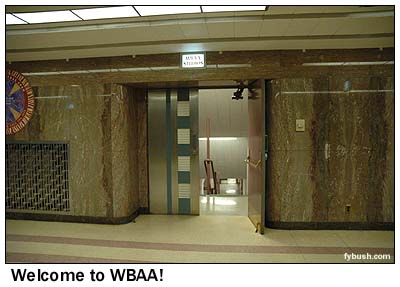 Regular
readers of this column know by now that we have this thing about
Indiana. It's not that we set out to become fascinated with the
broadcast scene in the Hoosier State, it's just that being married
to an ex-Hoosier means spending time in Indiana. A lot of time
in Indiana, in fact. And once you've seen the sites in Indianapolis
and Evansville and South Bend and Valparaiso and Richmond and
Muncie and, yes, Fort Wayne (over and over and over again), what
do you do then?
Regular
readers of this column know by now that we have this thing about
Indiana. It's not that we set out to become fascinated with the
broadcast scene in the Hoosier State, it's just that being married
to an ex-Hoosier means spending time in Indiana. A lot of time
in Indiana, in fact. And once you've seen the sites in Indianapolis
and Evansville and South Bend and Valparaiso and Richmond and
Muncie and, yes, Fort Wayne (over and over and over again), what
do you do then?
If you're us, you gather a couple of equally crazed friends and you plot out a 48-hour itinerary that includes stops in Peru, Wabash, Marion, Kokomo, Lafayette, West Lafayette (two very distinct communities), Logansport and Rochester. And if the January weather turns nasty? As long as the guy who drove all the way from Ohio doesn't mind driving, you pile into the car and set out anyway. (Attention, Indiana highway departments: Salt. Plows. Look into it...)
The good news is that by the time we made it to the final hours of the trip, the nastiest of the winter weather had subsided and the roads were a little more clear. And by the time we made it to the Purdue University campus in West Lafayette after lunch, the worst we had to deal with - we thought - was the bitterly cold wind. Which may explain why your editor wasn't looking down as our group headed across the campus toward the Elliott Hall of Music, and why said editor unexpectedly (and, according to eyewitnesses, kind of humorously) found himself flat on his back after slipping on a bad patch of black ice. (Ouch!)
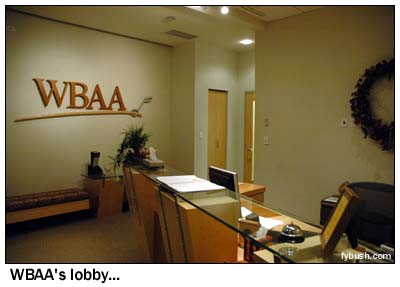
|
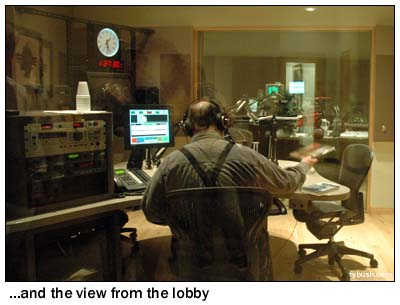
|
The show must go on, though, and our group found its way into the beautiful Art Deco marble lobby of the Music Hall and then down the stairs to the WBAA lobby to meet station manager Dan Skinner. After admiring the lobby, which features a floor-to-ceiling window into the adjacent studio cluster, our first stop was the first aid kit, where a scraped elbow was patched up before continuing with the tour.
As we mentioned when we showed you the AM transmitter site last week, WBAA's history on the AM dial goes back to 1922, with a legacy of wireless experimentation at Purdue that stretches back to 1910. In 1941, WBAA moved from studios in the Electrical Engineering Building (which had also been its transmitter site - we're told the old longwire antenna remained in place there for many decades) to what were then state-of-the-art studios in the basement of Elliott Hall of Music. Long before "public radio" became a household word, WBAA was informing, educating and entertaining Indiana here at Purdue - and providing students with an excellent education in radio programming and engineering, too.
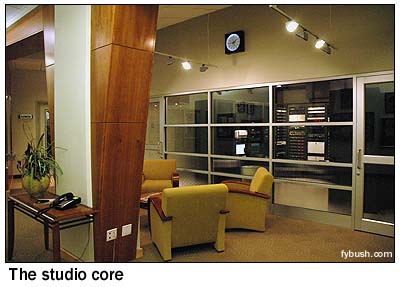
|
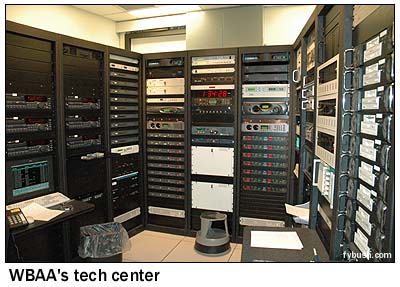
|
In 1993, WBAA added FM service with the debut of WBAA-FM (101.3 West Lafayette), also operating from the 1941-vintage studios in Elliott, with a transmitter site south of the AM towers. (Some useless trivia: the initial callsign for 101.3 was assigned sequentially, falling between WFUB 97.3 Orange MA and WFUD 107.3 Honeoye Falls NY. Small wonder that Purdue officials quickly had it changed...)
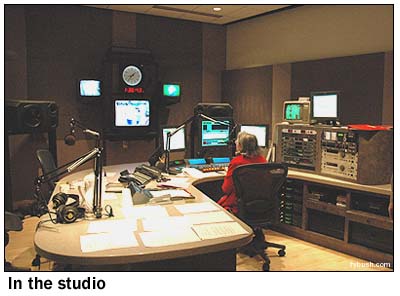
|
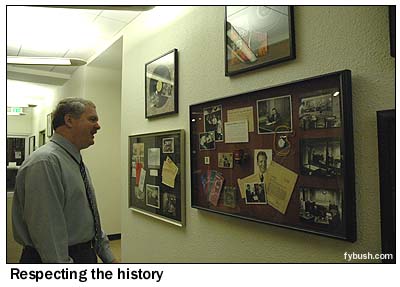
|
By the turn of the 21st century, the old studios in Elliott were showing their age, and WBAA embarked upon a $2 million project to completely rebuild the facility. The results, completed in early 2002, are stunning: from the lobby, we enter a reception area that looks into an arc of studios with a tech center (above) at its heart. On either side of the tech center are identical pairs of studios and control rooms that provide plenty of flexibility for WBAA's dual program streams - news and talk on the AM side, classical music and NPR's flagship Morning Edition and All Things Considered on the FM side.
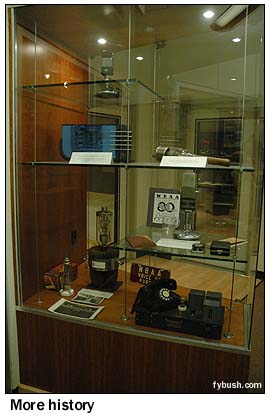 The
control rooms are magnificent - those are Corian countertops
and Logitek control surfaces in each room.
The
control rooms are magnificent - those are Corian countertops
and Logitek control surfaces in each room.
And if you're downstairs and can't look outside to see what the weather's like, what do you do? If you're WBAA, you install multiple monitors in each control room, including one that's connected to a camera looking out on the outside world.
Even though the studios sit right below the 6,000-seat Elliott Hall auditorium and adjacent to the Purdue Band's practice rooms, they're remarkably quiet - and despite the big glass windows, they sound wonderful, too.
(Credit Russ Berger Design Group, the same folks who did NPR's own facilities in Washington, for the nice work here, by the way.)
It's nice to see that the station's long history wasn't forgotten during the renovation. The wall facing the studio arc is lined with framed montages of station memorabilia, including old transcription disks, scripts, letters, photos and more. (That's Dan Skinner admiring them in the photo above.)
On each end of the arc, a tall display case is filled with more concrete pieces of WBAA's history - transmitter tubes, remote transmitters, microphones, tape recorders and other vintage technology.
This area was rebuilt first, while WBAA continued to operate from its old studios toward the back of the hall. Once the new studios were ready, that old space was demolished and rebuilt with production rooms, offices, a music library and an engineering shop. It's not a huge facility by any means, but it's an awfully nice one.
We could easily spend all day here, but there's still more to see - for instance, the only TV studio we'll see this trip. WLFI-TV (Channel 18) is licensed to Lafayette, but its studios are on the north side of West Lafayette, off the US 52 bypass on Yeager Road. We get there just in time to catch chief engineer Carl Booker before he heads out to see how the transmitter site is handling all that ice, and we get a nice tour of the place, which is a former box factory.
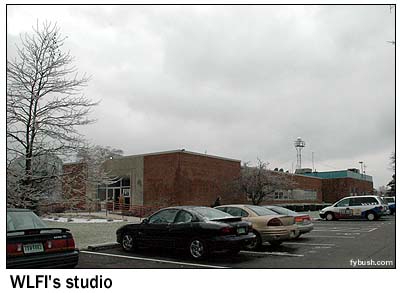
|
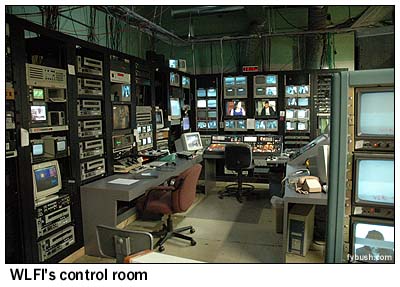
|
We start at the back of the building, in the control room, which isn't really where WLFI's master control is these days. For the last few years, the station's been owned by LIN Broadcasting, which is a big proponent of hubbed master control facilities - so WLFI's programming is actually controlled out of WISH-TV down in Indianapolis (which also handles LIN stations in Fort Wayne, Dayton and even Buffalo.) This control room handles local newscasts and can take over MCR duties if the microwave link to Indianapolis goes down.
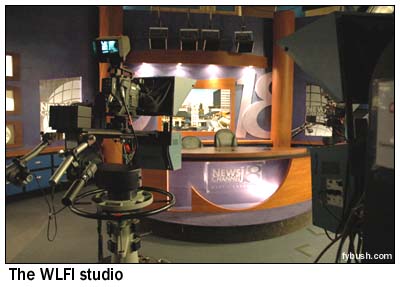
|
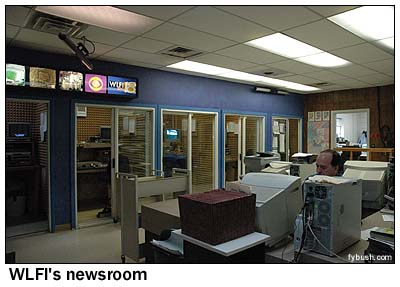
|
Next door to the control room is the studio, which is unusual in two respects - first, the floor is carpeted, and second, the walls don't go all the way to the ceiling. That's not as much of a problem as you'd expect in a small station like this, though, because when the news is on, everyone in the building's working on the show! (We'd had a chance to see WLFI's storm coverage the night before, and it was very well done for a market this size. When you're the only TV station in the area, you can really connect with your audience, and WLFI sure does.)
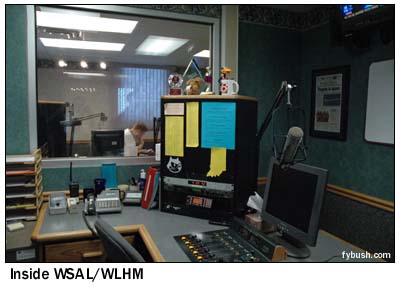 Down
the hall in one direction are production offices and other office
space; in the other direction, heading back out to the lobby,
are the two rooms that make up the newsroom. Again, nothing fancy,
but it gets the job done.
Down
the hall in one direction are production offices and other office
space; in the other direction, heading back out to the lobby,
are the two rooms that make up the newsroom. Again, nothing fancy,
but it gets the job done.
(A quick bit of history here, too, before we move on: the station began in 1953 as WFAM-TV 59, co-owned with WASK radio. It later moved to channel 18, and was at one time owned by southern Indiana television pioneer Sarkes Tarzian, who also owned WTTV in Bloomington/Indianapolis and WPTA in Fort Wayne. And I'm told that these studios have been in use since the seventies, and that the transmitter, seen last week, moved to its current location from a spot closer to town around that same time.)
From here, after a quick drive past the nearby studios of WGLM (106.7 West Lafayette), it's off to the northeast on Indiana 25, heading for the small town of Logansport and WSAL (1230)/WLHM (102.3), which sit in a new studio facility right on the corner of Market Street, the main drag through downtown.
Vice President/GM Andy Eubank shows us inside, past the sales area, down the hall to the engineering racks and then into the spacious studio area, where both the AM (full-service adult contemporary) and FM (hot AC "Mix 102.3") are live and local this afternoon. That's the newsroom, above, which looks into both the AM and the FM studios (we're looking into the FM here) - and just outside, in the space between the two studios, is a little history display consisting of a vintage radio, an old teletype machine and a modern laser printer.
Down the road from WLHM/WSAL is the studio of the other radio station in town, Mid-America's WHZR (103.7 Royal Center). "Hoosier Country" has its studios in a house along Market Street (the main drag), while its transmitter is north of town along 25, where we'll see it from a distance on the way out of town.
First, though, we head east on Market past the Logansport Mall to see the WSAL/WLHM tower (at right), after which we backtrack to get a snack at a neat soda fountain/ice cream shop that was making all of us hungry as we drove past it on the way to the tower. (Indeed, the ice cream was both plentiful and remarkably inexpensive.)
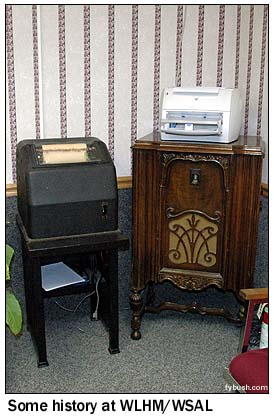
|
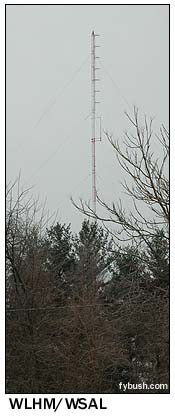
|
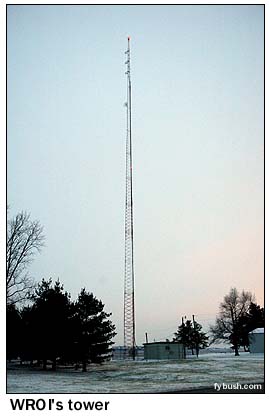
|
We're now in "chasing the sunset" mode as we head north on 25 to our final destination of the trip, the charmingly-named community of Rochester, Indiana. Remarkably, despite being a native of Rochester, N.Y., your editor had never been in Rochester, Indiana - and tuning in to WROI (92.1 Rochester) as we approached the town, the sound of what appeared to be a live jock buoyed hopes of being able to walk into the station and offer greetings from that other Rochester.
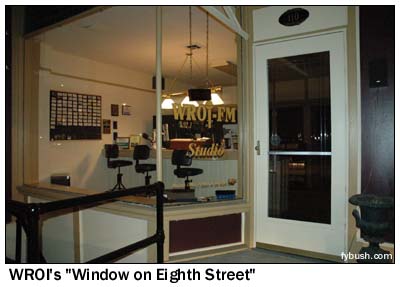 There
was just enough daylight remaining to get a nice picture of WROI's
self-supporting tower and three-bay antenna on the west side
of town (off Indiana 14), and though it was dark by the time
we pulled into downtown Rochester to find the WROI storefront
studios ("Window on Eighth Street") across from the
picturesque courthouse square, the lights indeed appeared to
be on inside.
There
was just enough daylight remaining to get a nice picture of WROI's
self-supporting tower and three-bay antenna on the west side
of town (off Indiana 14), and though it was dark by the time
we pulled into downtown Rochester to find the WROI storefront
studios ("Window on Eighth Street") across from the
picturesque courthouse square, the lights indeed appeared to
be on inside.
Alas, the jock giving time-and-temperature and the news guy with whom he was bantering were either voicetracked or emanating from somewhere else deep within the building, so the best we could do was to peer through the window and hope to return to Rochester sometime soon, preferably during regular business hours.
(One more nice moment remained on the drive along 14 back to Fort Wayne: our driver, Mike Ward of Akron, Ohio, got his own hometown-namesake moment as we passed through the little hamlet of Akron, Indiana...)
So after the frigid, icy, elbow-skinning conditions of central Indiana, where do we go now? Hope the South Pacific sounds good, because next week, it's a special Guest Tower Site of the Week featuring sunny, warm American Samoa. See you then!
 It's here - the
2005 Tower Site Calendar is now available at special clearance
prices! Click
here for ordering information!
It's here - the
2005 Tower Site Calendar is now available at special clearance
prices! Click
here for ordering information!
- Previous Site of the Week: Central Indiana, part III
- Next Week: American Samoa
- Site of the Week INDEX!
- How can you help support Site of the Week? Click here!
- Submit your suggestions for a future Site of the Week!
